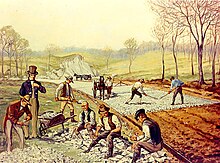Road transport
The first methods of road transport were horses, oxen or even humans carrying goods over dirt tracks that often followed game trail.With the advent of the Roman Empire, there was a need for armies to be able to travel quickly from one region to another, and the roads that existed were often muddy, which greatly delayed the movement of large masses of troops.Starting in the early 18th century, the British Parliament began to pass a series of acts that gave the local justices powers to erect toll-gates on the roads, in exchange for professional upkeep.This became the pattern for the turnpiking of a growing number of highways, sought by those who wished to improve flow of commerce through their part of a county.[9] Although turnpiking did result in some improvement to each highway, the technologies used to deal with geological features, drainage, and the effects of weather were all in their infancy.[10] British turnpike builders began to realize the importance of selecting clean stones for surfacing while excluding vegetable material and clay, resulting in more durable roads.He also designed his roads so that they sloped downwards from the centre, allowing drainage to take place, a major improvement on the work of Trésaguet.Modern tarmac was patented by British civil engineer Edgar Purnell Hooley, who noticed that spilled tar on the roadway kept the dust down and created a smooth surface.[20] Hooley's 1901 patent involved mechanically mixing tar and aggregate prior to lay-down and then compacting the mixture with a steamroller.Modern controlled-access highways originated in the early 1920s in response to the rapidly increasing use of the automobile, the demand for faster movement between cities and as a consequence of improvements in paving processes, techniques and materials.The Bronx River Parkway was the first road in North America to utilize a median strip to separate the opposing lanes, to be constructed through a park and where intersecting streets crossed over bridges.In Canada, the first precursor with semi-controlled access was The Middle Road between Hamilton and Toronto, which featured a median divider between opposing traffic flow, as well as the nation's first cloverleaf interchange.This highway developed into the Queen Elizabeth Way, which featured a cloverleaf and trumpet interchange when it opened in 1937 and until the Second World War boasted the longest illuminated stretch of roadway built.[30] Thus as originally conceived, a freeway is a strip of public land devoted to movement to which abutting property owners do not have rights of light, air or access.On cross-border transportation the trucker will present the cargo and documentation provided by the shipper to customs for inspection (for EC see also Schengen Agreement).[32] To avoid accidents caused by fatigue, truckers have to adhere to strict rules for drive time and required rest periods.Modern pavements are designed for heavier vehicle loads and faster speeds, requiring thicker slabs and deeper subbase.They are multipurpose; they can provide a margin of side clearance, a refuge for incapacitated vehicles, an emergency lane, and parking space.They were manually operated, and consisted of semaphores, flags or paddles, or in some cases colored electric lights, all modeled on railroad signals.For instance, curbs and rumble strips can be used to keep traffic in a given lane and median barriers can prevent left turns and even U-turns.They typically paralleled or replaced routes already with some volume of commerce, hoping the improved road would divert enough traffic to make the enterprise profitable.Another improvement, better grading to lessen the steepness of the worst stretches, allowed draft animals to haul heavier loads.Companies were formed to build, improve, and maintain a particular section of roadway, and tolls were collected from users to finance the enterprise.The word turnpike came into common use in the names of these roadways and companies, and is essentially used interchangeably with toll road in current terminology.The demise of this early toll road era was due to the rise of canals and railroads, which were more efficient (and thus cheaper) in moving freight over long distances.Roads wouldn't again be competitive with rails and barges until the first half of the 20th century when the internal combustion engine replaces draft animals as the source of motive power.The first limited access highways were Parkways, so called because of their often park-like landscaping and, in the metropolitan New York City area, they connected the region's system of parks.In the late 1940s and early 1950s, after World War II interrupted the evolution of the highway, the US resumed building toll roads.It uses 12 foot (3.65m) lanes, wide medians, a maximum of 4% grade, and full access control, though many sections don't meet these standards due to older construction or constraints.The newest policy passed by Congress and the Obama administration regarding highways is the Surface and Air Transportation Programs Extension Act of 2011.












Nissan Tsuru (B13)Flying PigeonroadsterMAZ-303Scania R440TransportArmored fighting vehicleBicycleHuman-poweredAnimal-poweredPersonal rapid transitPipeline transportPowered exoskeletonRapid transitSupersonicUncrewed vehicleVactrainVelomobileWalking9-Euro-TicketAccessibilityAccessibility levelAlternatives to car useBicycle transportationCyclabilityCycling infrastructureEngineeringGreen transport hierarchyHistoryOutlinePublicPersonalFree public transportTimetablePrivateSustainable transportTimelineTransport divideTransportation planningautomobileanimalRomansPersiansempirestrucking companiesmass transitsignageintersectionscontrolled-access highwayspickup truckvehiclesbike courierscycle rickshawsHistory of road transportTrajan's Columnhorsesdirt tracksRoyal RoadsRoman Empirelarge masses of troopsRoman roadsCaliphatetar-pavedBaghdadRenaissanceGreat North RoadBritish ParliamentChesterWest AfricaAshanti Empirenetwork of well-kept roadsDahomeytoll roadsKpenglaAbomeyOuidahRoad constructionJohn MetcalfYorkshireThomas TelfordJohn Loudon McAdamPierre-Marie-Jérôme TrésaguetIndustrial Revolutionturnpike roadconvexrainwaterscientific approachroad buildingbase courseLondon to Holyhead roadJohn MacNeillmacadamcarriageGood Roads Movementrural areasmacadam roadsMillwallsubgradeEdgar Purnell HooleysteamrollerPortland cementAutostrada dei LaghiAutostrada A8Autostrada A9controlled-access highwayLong Island Motor ParkwayLong IslandNew Yorkbanked turnsguard railstarmacManual on Uniform Traffic Control Devicesdual highwaysLake ComoLake MaggiorePiero PuricelliautostradaSouthern State ParkwayNorthern State ParkwayGrand Central ParkwayBonn-Cologne AutobahnKonrad AdenauerCologneThe Middle RoadHamiltonToronto
